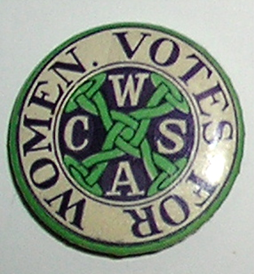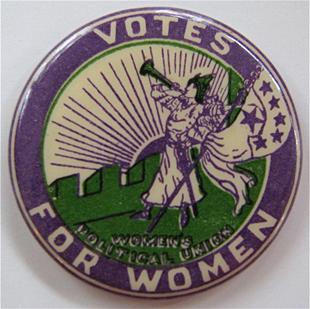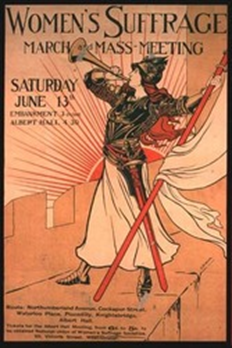The Women’s Suffrage Movement lasted for over 70 years. Major contributors fought for women’s rights on state-to-state and national level. Well-known contributors include Susan B. Anthony, Elizabeth Cady Stanton, Lucy Stone, and Julia Ward Howe. While these women originally formed two groups that opposed each other, they eventually joined to create the National American Woman Suffrage Association (NWSA). Not long after the NWSA was formed, Western states began to grant women the right to vote. However, the Eastern and Southern states resisted. On August 18, 1920, the 19th Amendment was passed and written into the Constitution.
The Connecticut Woman Suffrage Association
Although the NWSA was a major suffrage organization, there were other influential local organizations throughout the country. One example is the Connecticut Woman Suffrage Association (CWSA). On October 28, 1869, the CWSA was formed during Connecticut’s inaugural suffrage convention. Isabella Beecher Hooker, Frances Ellen Burr, Catharine E. Beecher, and Harriet Beecher Stowe were leaders of the CWSA. The CWSA was a key component in advocating for women’s suffrage throughout Connecticut. They advocated by submitting bills to legislature and testifying at hearings. With the help of other local organizations, Connecticut promoted women’s suffrage for the country. From 1913 to 1917, Katharine Houghton Hepburn, mother of famous actress Katharine Hepburn, served as president of the organization.
The Chain Link Button

The CWSA created a pinback button with the words “Votes for Women” and their acronym. The chain link design is inspired by Emmeline Pankhurst’s organization, the Women’s Social and Political Union (WSPU). With the WSPU hailing from England, their tactics leaned toward the militant side of the suffrage movement. As for the chain link design itself, there is no historical precedent for calling it a chain link. It could also be viewed as a woven design. The colors of the button are also borrowed from the WSPU design in traditional green, purple, and white. The WSPU adopted the purple, green, and white colors in 1908. They chose purple for royalty, white for purity, and green for hope as “the emblem of spring” (“Symbols of the Women’s Suffrage Movement,” n.d.). These three colors alternate on the pinback button with purple being at the center of the button and as the font color of the “Votes for Women” phrase, green being the color of the chain link and as the outer border, and white being the background behind the phrase and as the font color of the “CWSA” logo.
The Women’s Political Union
Another example of a local influential organization is the Women’s Political Union (WPU). The WPU was created by Harriot Stanton Blatch, daughter of Elizabeth Cady Stanton, in New York. Originally called the Equality League of Self-Supporting Women, the WPU borrowed from English ideals to modernize the movement. The WPU hosted outdoor meetings and organized parades to gain publicity for the suffragettes. These open-air events not only gained publicity but also heightened women’s commitment to the suffrage movement. While these ideals were more militant, the WPU never used violence.
The Clarion Button


The Clarion pinback button is a classic design of the suffrage movement. The WPU took inspiration from an English organization called the Women's and Social and Political Union (WSPU) by using the very classic purple, green, and white colors and the “Bugler Girl” motif. This design was created by British artist, Caroline Watts. Caroline Watts was a member of the Artists Suffrage League and would complete various art commissions for suffrage organizations. In 1908, Caroline Watts designed a poster for the National Union for Women Suffrage Societies march. On that poster was the “Bugler Girl”. Crawford suggests Caroline Watts was inspired by her past commissions that reference heroism and fantasy. Although the NUWSS was non-militant, the design could be seen as militant because of the sheath at the woman’s side. Harriot Stanton Blatch liked this militant figure and so it was used for the WPU pinback button. In 1913, the title of the pinback button changed from Bugler Girl to Clarion. There are several versions of the pin, with the number of stars on the flag increasing as more U.S. states began to grant the women the right to vote. The original Clarion button has four versions: five stars, six stars, eleven stars, and a smaller version with the phrase “Equal Suffrage” and has ten stars. There is a larger variety that was made later with twelve stars and then, thirteen stars. Because so many states began granting the women the right to vote, the updating of the Clarion pinback button stopped at thirteen stars.
Timeline of Suffrage events
1848: Abolitionists hold a two-day conference called the Seneca Falls Convention in New York to discuss women’s rights
February 26, 1869: The 15th Amendment grants Black men the right to vote
May 15, 1869: The National Woman Suffrage Association (NWSA) is formed by Susan B. Anthony and Elizabeth Cady Stanton in opposition to supporting the 15th Amendment throughout the country
November 24, 1869: The American Woman Suffrage Association (AWSA) is formed by Lucy Stone, Julia Ward Howe, and others in support of the 15th Amendment
1869: Wyoming Territory allows women the right to vote
1870: Utah Territory allows women the right to vote
1883: Washington Territory allows women the right to vote
1887: Montana Territory allows women the right to vote
1890: Both the NWSA and the AWSA join to form the National American Women Suffrage Association (NAWSA)
1890: Wyoming is the first to grant women the right to vote
1893: Colorado grants women the right to vote
1896: Utah and Idaho grant women the right to vote
1910: Washington grants women the right to vote
1911: California grants women the right to vote
1912: Arizona, Kansas, and Oregon grant women the right to vote
1914: Montana and Nevada grant women the right to vote
1917: New York grants women the right to vote
1918: Michigan, Oklahoma, and South Dakota grant women the right to vote
August 18, 1920: The 19th Amendment grants women the right to vote throughout the country
Sources
Anthony, S. B., Gage, M. J., & Harper, I. H. (1922). The History of Woman Suffrage. New York: Fowler & Wells. https://archive.org/details/historywomansuf00harpgoog/page/n4/mode/2up
Crawford, E. (N.d.). Suffrage stories/women artists: Caroline Watts and the ‘Bugler Girl’. https://womanandhersphere.com/2014/12/03/suffrage-storieswomen-artists-…
Connecticut History.org. (N.d.). Women win the right to vote. https://connecticuthistory.org/women-win-the-right-to-vote/
CT State Library. (N.d.). Woman Suffrage Association, Connecticut, 1869-1921 (RG 101). https://ctstatelibrary.org/RG101.html
DuBois, E. (1987). Working women, class relations, and suffrage militance: Harriot Stanton Blatch and the New York Woman Suffrage Movement, 1894-1909. The Journal of American History, 74(1), 34-58. doi:10.2307/1908504
Florey, K. (2020). Personal interview.
Florey, K. (N.d.). Suffrage buttons. http://womansuffragememorabilia.com/woman-suffrage-memorabilia/suffrage…
Jenkins, J. (2015). Katharine Houghton Hepburn, a woman before her time. https://connecticuthistory.org/katharine-houghton-hepburn-a-woman-befor…
Marilley, S. M. (1996). Woman Suffrage and the Origins of Liberal Feminism in the United States, 1820-1920. London: Harvard University Press. https://books.google.com/books?id=SQ7PP7qSkRsC&printsec=frontcover&sour…
National Constitution Center. (N.d.). Map: States grant women the right to vote. https://constitutioncenter.org/timeline/html/cw08_12159.html
National Park Service. (N.d.). Symbols of the Women’s Suffrage Movement. https://www.nps.gov/articles/symbols-of-the-women-s-suffrage-movement.h…
Nelson, B. (2020). 20 states where women could vote before 1920. Readers Digest.
https://www.rd.com/article/states-where-women-could-vote-before-1920/
New York State Museum. (N.d.). Harriot Stanton Blatch (1856-1940). http://www.nysm.nysed.gov/biographies/harriot-stanton-blatch
